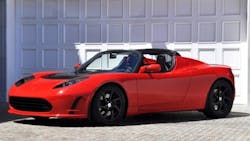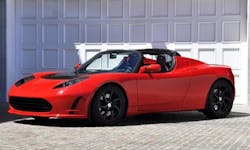Tesla Updates its Roadster to Achieve 400 Mile Range on a Single Charge
As reported by CEO Elon Musk, Tesla Motors will employ several improvements that are predicted to achieve a 40-50% improvement on range between the original Roadster and the new Roadster 3.0 (see figure). There is a set of speeds and driving conditions where the company is confident it can drive the Roadster 3.0 over 400 miles on a single charge. It will be demonstrating this in the real world during a non-stop drive from San Francisco to Los Angeles in the early weeks of 2015.
The company notes that battery technology has continued a steady improvement in recent years, as has its experience in optimizing total vehicle efficiency through Model S development. The company has wanted to apply the experience gained from its first vehicle, and are going to do that with the prototype Roadster 3.0 package. It consists of three main improvement areas.
Figure. Tesla predicts that its Roadster 3.0 will have a 400 mile driving range.
Batteries
The original Roadster battery was the very first lithium ion battery put into production in any vehicle. It was state of the art in 2008, but cell technology has improved substantially since then. It has identified a new cell that has 31% more energy than the original Roadster cell. Using this new cell it has created a battery pack that delivers roughly 70kWh in the same package as the original battery.
Aerodynamics
The original Roadster had a drag coefficient (Cd) of 0.36. Using modern computational methods it expects to make a 15% improvement, dropping the total Cd down to 0.31 with a retrofit aero kit.
Rolling Resistance
The original Roadster tires have a rolling resistance coefficient (Crr) of 11.0 kg/ton. New tires for the Roadster 3.0 have a Crr of roughly 8.9 kg/ton, about a 20% improvement. It is also making improvements in the wheel bearings and residual brake drag that further reduce overall rolling resistance of the car.
Appointments for upgrading Roadsters will be taken this spring once the new battery pack finishes safety validation. Tesla is confident that this will not be the last update the Roadster will receive in the many years to come.
In addition CEO, Elon Musk said, "BTW, we are actually working on a charger that automatically moves out from the wall & connects like a solid metal snake. This can be used with all existing Model S cars, not just future ones."
Last year, Tesla produced more than 22,000 cars; this year it is on track to build about 35,000. By the end of 2015, it will have increased production by another 50 percent. With Model X on the horizon, Dual Motor Model S now in production, and increasing global demand, the company decided to temporarily pause production in order to increase capacity at the Tesla Factory in Fremont, California.
During the pause in production, the company:
· Upgraded the assembly line
· Added capacity to the body shop
· Enhanced powertrain assembly
· revamped facilities for its employees
The result of this retooling phase, which complemented ongoing upgrade work, is a much-expanded operation that allows the company to produce more cars, faster, while increasing automation and providing a more inviting work environment.
Elon Musk said that the most dramatic changes are to be found in general assembly, where Tesla eliminated a lot of overhead steel and mechanical structures in favor of advanced robots that can lift and maneuver entire cars with optimum precision while taking up less room. Soon, these new robots will even be able to install battery packs in the cars, relieving humans of the most labor-intensive operation in the factory and reducing installation time from four to two minutes.
Alongside the robots, Tesla created a more efficient floor plan with significantly more automation. In addition, the cars now move down the assembly line as associates work on them, enabling a streamlined and more consistent workflow. The line is now running at about 1,000 cars a week with the potential for significantly more with minor adjustments.
In the powertrain department, Tesla added conveyors and advanced robots that have given them the capacity to process 1 million battery cells per day, up from 800,000. In body-in-white, they’ve added new welding equipment and improved production uptime by 5 to 10 percent, thanks in part to a 13-car buffer that guards against bottlenecks. Also added are 24 new tire and export docks to the perimeter of the main building, increasing the speed with which it can deliver cars overseas.
As well as making the place brighter by installing skylights, replacing fluorescent lights with energy-saving LED lamps, and painting previously grey walls and floors a bright white, they’ve added a few novel touches. For instance, it wrapped several pillars with climbing plants to add some greenery to the surrounds. They had a comic artist depict the manufacturing process in a series of illustrations, which were printed on the glass walls enclosing some of the robots. And they’ve added a wall of framed photos showing the factory building in different guises over its 54-year life.
Elon Musk is the CEO and Product Architect of Tesla Motors and the CEO and Chief Designer of Space Exploration Technologies (SpaceX). At Tesla, Elon has overseen product development and design from the beginning, including the all-electric Tesla Roadster, Model S and Model X. Transitioning to a sustainable energy economy, in which electric vehicles play a pivotal role, has been one of his central interests for almost two decades, stemming from his time as a physics student working on ultracapacitors in Silicon Valley.
About the Author

Sam Davis Blog
Editor-In-Chief - Power Electronics
Sam Davis was the editor-in-chief of Power Electronics Technology magazine and website that is now part of Electronic Design. He has 18 years experience in electronic engineering design and management, six years in public relations and 25 years as a trade press editor. He holds a BSEE from Case-Western Reserve University, and did graduate work at the same school and UCLA. Sam was the editor for PCIM, the predecessor to Power Electronics Technology, from 1984 to 2004. His engineering experience includes circuit and system design for Litton Systems, Bunker-Ramo, Rocketdyne, and Clevite Corporation.. Design tasks included analog circuits, display systems, power supplies, underwater ordnance systems, and test systems. He also served as a program manager for a Litton Systems Navy program.
Sam is the author of Computer Data Displays, a book published by Prentice-Hall in the U.S. and Japan in 1969. He is also a recipient of the Jesse Neal Award for trade press editorial excellence, and has one patent for naval ship construction that simplifies electronic system integration.

